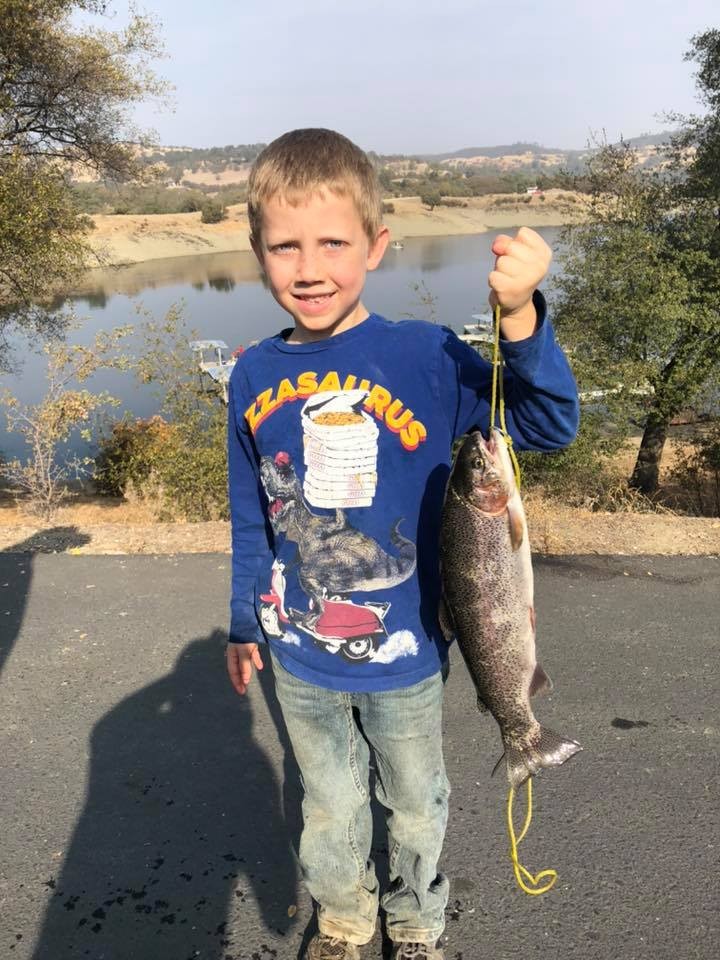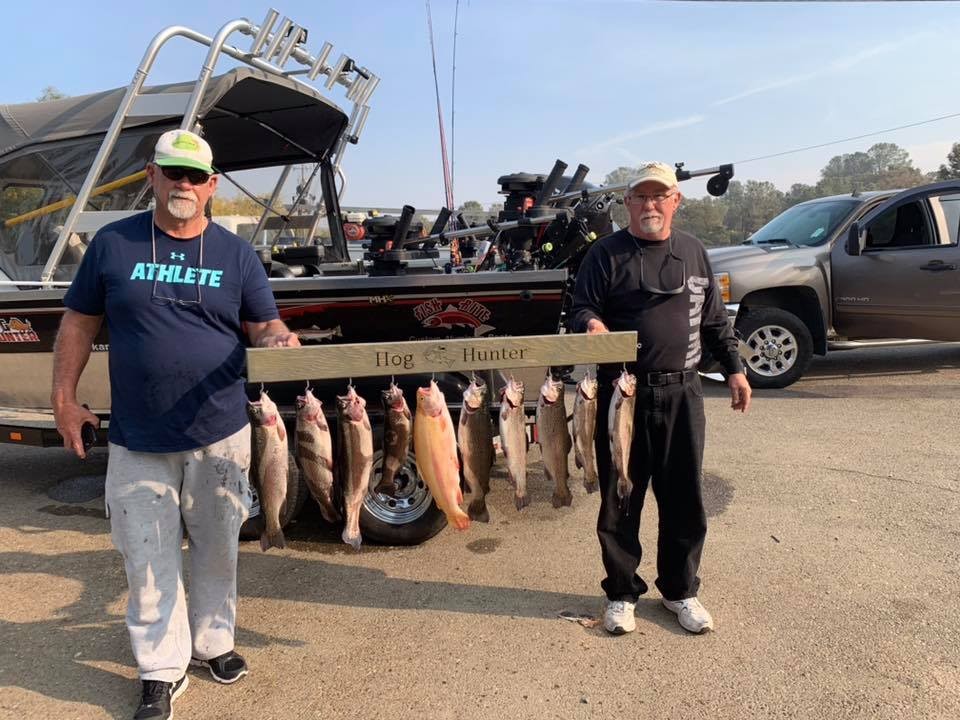By Cal Kellogg
Later the fog would burn off, but just after dawn when I arrived a heavy overcast hung just above the lake and the bank was wet and slick with dew. The muddy shore gave way to the seemingly black water. With zero wind the lake’s surface took on the properties of a giant mirror punctuated with spirals of faint mist that slowly crept toward open water.
Working at the water’s edge, I rigged my spinning rod with a clear bobber, followed by a 30-inch leader sporting a No. 8 black woolly bugger. Once the bobber was filled with the water it probably weighed over an ounce.
Bringing the rod back I let go with a blistering cast. The heavy bobber combined with the fact that the reel was spooled with fine diameter 8-pound mono allowed me to shoot the fly far down range, thereby allowing me to cover a maximum amount of territory from my outpost on the bank.
When the rig splashed down I allowed it to settle below the surface for a moment and then started a slow steady retrieve with the bobber just beneath the surface.
As the bobber and fly came into sight 30 feet away I was already thinking about my next cast when I detected a flash behind the gear. A beat later the water swirled and my line came to life.
The trout’s first reaction to the sting of the hooked was a brief but vigorous series of headshakes. When that failed to shake the fly loose, the fish panicked and bolted. Line screamed out of my reel against the resistance of the drag.
For the next several minutes I kept the pressure on the fish as my buddy followed me back and forth, up and down the bank, net in hand. At one point I almost had the trout within range of the long-handled net only to have it storm off on a sustained 20 foot run that ended when the fish catapulted out of the water!
With all the acrobatics, I fully expected the hook to be tossed, but luck must have been on my side. Gradually I was able to work the 20-inch trout to the bank and my partner closed the deal with a deft scoop of the net. While the rainbow was in the 3-pound class, based on the fight alone I expected it to be even larger, such was my introduction to trouting at Lake Amador several winters ago…
For the uninitiated, Lake Amador is a relatively small Motherlode lake totaling 425 surface acres when at full capacity. The lake sits at an elevation of 485 feet. If you are looking for a pristine high Sierra trout fishing experience you’ll need to look elsewhere, but if you want to catch some of the largest, hardest fighting and healthiest planters available in the northern half of the state Amador is the place to go.
The Lockhart family has been running Lake Amador for over 30 years and they’ve stayed focused on a single goal…creating one of the finest fishing destinations in the Western United States. The lake is home to trophy size Florida strain largemouths, huge 30 plus pound catfish and vast clouds of panfish, but these species are just appetizers. Trout fishing is what occupies the spotlight at Amador.
Okay, so far you know the lake is fairly small and it’s jam-packed with trout. Now you want to know how to catch them. Let’s go fishing!
Amador’s trout treat both boaters and bank anglers well. Most of the trout fishing I’ve done at Lake Amador has been from the bank so let’s start there.
I’m a big believer in the “big bait, big fish” philosophy and lots of times, big baits do translate into big fish, but Lake Amador is a notable exception to this rule. Small and subtle presentations generally win the day at Amador. To be sure any standard lure or bait that bank anglers use to hook trout anywhere in Northern California will hook trout at Amador some of the time, just remember that for consistent success going small is the way to go.
Dough baits like PowerBait and Zeke’s Sierra Gold both work well at Amador, provided you use bait balls no more than ¼ inch in diameter. Berkley Power Eggs are a popular and productive bait at Amador and produce well when fished off the bottom or drifted beneath a bobber.
Worms can work well, but you don’t want to fish a whole inflated ‘crawler like you would at other lakes. Instead, inflate a 1-inch piece from the head end of the worm and pin it on a small fine wire hook.
For whatever reason, Amador’s trout are really drawn to the bank so when casting it’s important not to cast beyond the fish. As a general rule, I like to start off with my baits no more than 20 feet off the bank.
Lure tossing is popular among bank anglers, with spoons, spinners and small minnow plugs all producing results. All in all, 1/8 ounce Kastmasters in silver/blue and gold are one of the most effective pieces of hardware you can toss.
At the beginning of this piece I described catching a trout on a woolly bugger teamed with a clear water filled casting bobber. Truth be told I think tossing bubble and fly combos is not only one of the most effective, but also most exciting ways for a bank angler to hook Amador trout.
Some anglers prefer to fill their bobbers partially full of water, but I like to go with a completely full bobber. If there is air in the bobber you are limited to fishing near the surface. With a full bobber, you can fish your offering just beneath the surface or you can count the rig down to explore the water column a bit.
A full bobber makes a substantial splash when it hits the water and you might be worried that the splash will scare the trout. I used to worry about that, but over time I’ve come to believe that the splash actually attracts trout.
I generally start out working my full bubble just under the surface. I cast and immediately start my retrieve after splash down. I elevate the rod tip a bit and make my retrieve so I can just see the submerged bubble bulging the surface. The wake the bubble creates also seems to draw fish close. When they come to investigate and spot that fly its often FISH ON!
When steady near surface retrieves aren’t working, I’ll experiment with pauses and twitches and I’ll try counting the bubble down to various depths.
While my boat fishing experience at Amador is limited, my friend and fellow outdoor writer Jack Naves has a good deal of experience targeting the lake’s trout from his North River.
“During the popular winter season, trout at Lake Amador like to cruise the top five feet of the water column. When the fish are up high, top lining is the method of choice for trollers,” says Naves. If the water temperature is below 54 degrees, a slow approach is usually best. Try trolling at .9 to 1.5 miles per hour with your lures 50 to 120 feet behind the boat. My favorite winter trolling lures are 3” grubs, trolling flies behind clear wiggle-discs, plain woolly buggers, and pea-sized balls of PowerBait. I usually run my lures at Amador without adding any dodgers or flashers in front of them. I do, however, make some changes to the lures once I get them out of the box.”
“With woolly buggers, I trim off the tails so they look like little black dots moving through the water. I like to add a pea-sized ball of PowerBait or a Power Egg above my grubs. I’ll use a contrasting color – so with a white grub I’ll use pink, green, or dark brown. Sometimes with plain PowerBait I will add a 3” Power Worm as a trailer and upsize the ball of dough so it looks like a mutant pollywog. Sci-Fi trout fishing! For trolling flies, I like to pin a half-inch section of a night crawler on the hook just to give it some scent. And speaking of scent, I always smear my lures with a blend of oils and gels. My favorite scents for Lake Amador are shad and krill,” disclosed Naves.


